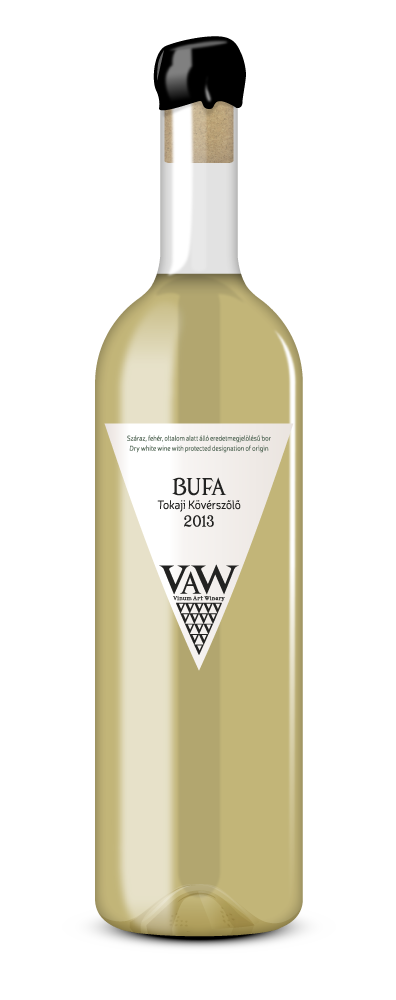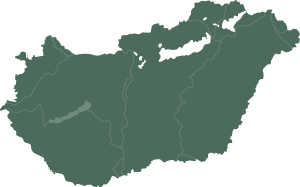Personal opinion:
Slightly fragrant, harmonic wine.
A youthfully fresh wine that contains a little residual sugar. It is a fat wine, raising full sensation, with gentle acids and the clear taste of table grapes.
In my judgement it is a unisex wine, and the companion of truly hot days.
Gastronomical pairing:
I recommend this wine to be consumed with bites of bread dipped into artisan extra virgin olive oil.
About the Kövérszőlő or “Fat grape” variety:
The Kövérszőlő is an ancient Hungarian white wine-grape variety that almost entirely died out in the “Phylloxera plague”. It received its name after the large size of its fruit.
Besides Tokaj and Transylvania the wine can also be found in Cotnari, Moldavia. It is a vegetative kind with strong growth. Its foliage is avocado green its leaves are serrated.
Its medium-sized cluster is loose and branchy. The berries are round, medium-sized, thin-skinned, punctate, soft-pulped, juicy and melting. Its wine is medium-maturing, harmonic, fiery, slightly fragrant, with a high sugar content and gentle acids. It ripens 10-14 days earlier than the Furmint, it can be harvested in the first half of October. It yields a lot of good quality aszú.
It is particularly sensitive to rot. Its frost- and drought-resistance is good.
The Királyleányka variety evolved from the Kövérszőlő and Leányka varieties.
The region and its history:
It cannot be established with surety today who originally planted the southern slopes of the Tokaj region (Hegyalja) with vine. It is, however, certain, that there was viniculture here already before the settlement of the Magyars in Hungary.
After the invasion of the Tatars (1241-1242) Béla IV invited Italian grape-growers into the country who settled in Olaszi (Bodrogolaszi), Sárospatak and Liszka (Olaszliszka). They, the Italian viniculturists, were the ones who laid the basis of international fame for the wine region, bringing with them the varieties of their homeland located more to the south. It is also a proven fact that the most illustrious variety in Tokaj, the Furmint, is also of Latin or Italian origin („mea nec Falernae temperant vites, neque Formiani pocula colles” [Horatius]).
The name Tokaj-Hegyalja came from the town of Tokaj and from the surrounding region originally only named Hegyalja (“piedmont”). The Hungarian name ‘Hegyalja’ was already in use in the 16th century. The Latin name of the region, Districtus Submontaneus or “Piedmont region” also appeared later as a public administration title.
The Tokaj castle was known all over Europe in the 16th-17th centuries, so foreign wine merchants looked for “Tokaj wine” in the entire “Hegyalja” region and the region became known all over Europe as “Tokaj’s highland” (in Latin: Montium vitiferorum Tokaiensis, in German: Tokayer Gebürg or Tokajer Wein-Gebürg). This was slowly neutralized also in the Hungarian parlance, and the area was called “Tokaj-Hegyaljának” from the 18th century onwards, besides the official “Hegyalja” name. The latter was only replaced officially by the name “Tokaj-Hegyalja” from the early 20th century.
It is an old saying that the Tokaj wine is the king of wines and the wine of kings. This divine wine speciality truly is the most distinguished of the premier Hungarian varieties, and it is also a fact that several royalties had the bottled Tokaj wine on their table. Not only royalties, however, but also the uncrowned monarchs of the arts.
(e.g.: Mozart, Goethe, Schubert, Baumberg, Rossini).
Climate and geography:
The Tokaj wine region is situated in an 87-kilometre long and 3-4-kilometre wide area of 5500 hectares, in a triangle bordered by three characteristic hills, that of Abaújszántó, the Sátor-hill of Sátoraljaújhely, and Tokaj’s Kopasz-hegy, bordered by 28 settlements.
The Tokaj wine region has a continental climate. In most places there is volcanic base-soil (andesite, rhyolite, and the tuffs of these), and black soil, rich in humidity, that evolved on this. On the volcanic rock, rich in minerals, full-bodied wines with vivid acids and mineral notes can be produced.
Because of the lower acid content, parts with yellow soil (e.g. the Kopasz-hill) are favourable for wines of a softer character; these slopes are more suitable for growing more fragrant varieties.
Botrytis cinerea – that causes the aszú process or noble rot – is not only characteristic of Tokaj-Hegyalja, but can also be found in other wine regions (Arad-hegyalja, Mór). However, due to the combination of the production site, the special micro-climate, the surrounding rivers (Bodrog, Tisza) and the right wine variety (Furmint, Hárslevelű or “Linden leaf”, Muscatel, Zeta, Kövérszőlő or “Fat grape”, Kabar) the aszú process occurs here, year after year. A characteristic feature of the cellar system of the wine region that is carved out of rhyolite tuff is the noble mould, Cladosporium cellare, covering the walls in a thick layer. W This is only found here and in the Rhein wine cellars, in the world. This fungus plays an important role in ensuring the quality of Tokaj wines.
NAME: BUFA
YEAR: 2013
VARIETY: Tokaji Kövérszőlő (“Fat grape”)
DISTRICT: Tokaj
CLASS: Dry white wine with protected designation of origin
Product of Hungary
Bottle volume: 750ml
Alc.13,5%vol
Contains sulphites


